英汉形容词对比.ppt.Convertor
- 格式:doc
- 大小:30.00 KB
- 文档页数:3
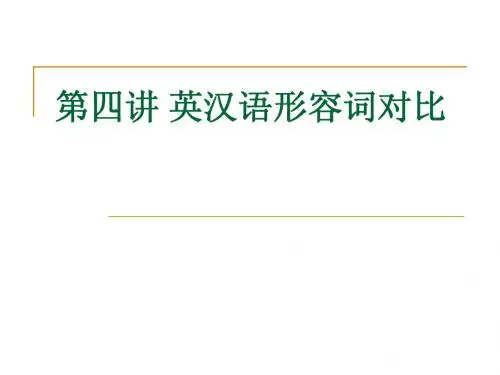

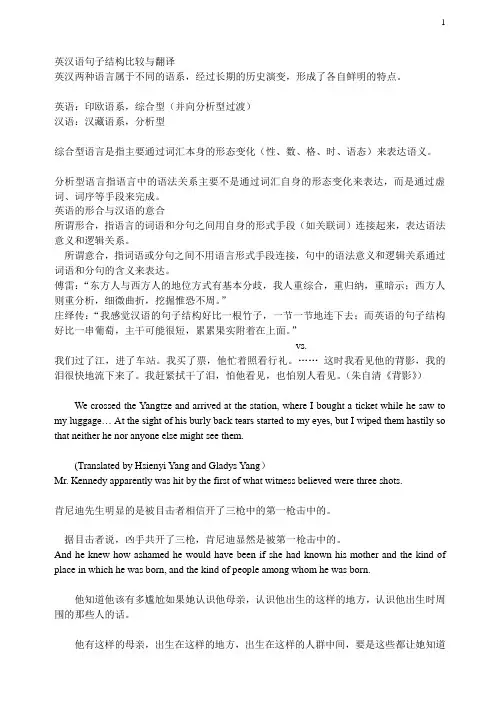
1英汉语句子结构比较与翻译英汉两种语言属于不同的语系,经过长期的历史演变,形成了各自鲜明的特点。
英语:印欧语系,综合型(并向分析型过渡)汉语:汉藏语系,分析型综合型语言是指主要通过词汇本身的形态变化(性、数、格、时、语态)来表达语义。
分析型语言指语言中的语法关系主要不是通过词汇自身的形态变化来表达,而是通过虚词、词序等手段来完成。
英语的形合与汉语的意合所谓形合,指语言的词语和分句之间用自身的形式手段(如关联词)连接起来,表达语法意义和逻辑关系。
所谓意合,指词语或分句之间不用语言形式手段连接,句中的语法意义和逻辑关系通过词语和分句的含义来表达。
傅雷:“东方人与西方人的地位方式有基本分歧,我人重综合,重归纳,重暗示;西方人则重分析,细微曲折,挖掘惟恐不周。
”庄绎传:“我感觉汉语的句子结构好比一根竹子,一节一节地连下去;而英语的句子结构好比一串葡萄,主干可能很短,累累果实附着在上面。
”vs.我们过了江,进了车站。
我买了票,他忙着照看行礼。
……这时我看见他的背影,我的泪很快地流下来了。
我赶紧拭干了泪,怕他看见,也怕别人看见。
(朱自清《背影》)We crossed the Y angtze and arrived at the station, where I bought a ticket while he saw to my luggage… At the sight of his burly back tears started to my eyes, but I wiped them hastily so that neither he nor anyone else might see them.(Translated by Hsienyi Y ang and Gladys Yang)Mr. Kennedy apparently was hit by the first of what witness believed were three shots.肯尼迪先生明显的是被目击者相信开了三枪中的第一枪击中的。
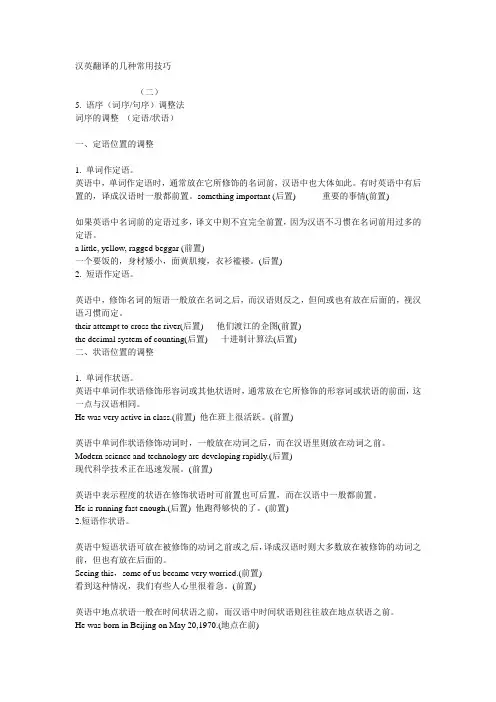
汉英翻译的几种常用技巧(二)5. 语序(词序/句序)调整法词序的调整(定语/状语)一、定语位置的调整1. 单词作定语。
英语中,单词作定语时,通常放在它所修饰的名词前,汉语中也大体如此。
有时英语中有后置的,译成汉语时一般都前置。
something important (后置) 重要的事情(前置)如果英语中名词前的定语过多,译文中则不宜完全前置,因为汉语不习惯在名词前用过多的定语。
a little, yellow, ragged beggar (前置)一个要饭的,身材矮小,面黄肌瘦,衣衫褴褛。
(后置)2. 短语作定语。
英语中,修饰名词的短语一般放在名词之后,而汉语则反之,但间或也有放在后面的,视汉语习惯而定。
their attempt to cross the river(后置) 他们渡江的企图(前置)the decimal system of counting(后置) 十进制计算法(后置)二、状语位置的调整1. 单词作状语。
英语中单词作状语修饰形容词或其他状语时,通常放在它所修饰的形容词或状语的前面,这一点与汉语相同。
He was very active in class.(前置) 他在班上很活跃。
(前置)英语中单词作状语修饰动词时,一般放在动词之后,而在汉语里则放在动词之前。
Modern science and technology are developing rapidly.(后置)现代科学技术正在迅速发展。
(前置)英语中表示程度的状语在修饰状语时可前置也可后置,而在汉语中一般都前置。
He is running fast enough.(后置) 他跑得够快的了。
(前置)2.短语作状语。
英语中短语状语可放在被修饰的动词之前或之后,译成汉语时则大多数放在被修饰的动词之前,但也有放在后面的。
Seeing this,some of us became very worried.(前置)看到这种情况,我们有些人心里很着急。
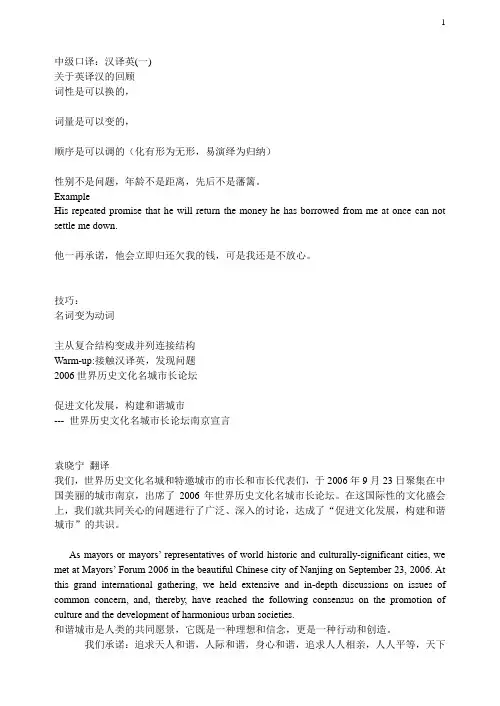
1中级口译:汉译英(一)关于英译汉的回顾词性是可以换的,词量是可以变的,顺序是可以调的(化有形为无形,易演绎为归纳)性别不是问题,年龄不是距离,先后不是藩篱。
ExampleHis repeated promise that he will return the money he has borrowed from me at once can not settle me down.他一再承诺,他会立即归还欠我的钱,可是我还是不放心。
技巧:名词变为动词主从复合结构变成并列连接结构Warm-up:接触汉译英,发现问题2006世界历史文化名城市长论坛促进文化发展,构建和谐城市--- 世界历史文化名城市长论坛南京宣言袁晓宁翻译我们,世界历史文化名城和特邀城市的市长和市长代表们,于2006年9月23日聚集在中国美丽的城市南京,出席了2006年世界历史文化名城市长论坛。
在这国际性的文化盛会上,我们就共同关心的问题进行了广泛、深入的讨论,达成了“促进文化发展,构建和谐城市”的共识。
As mayors or mayors’ representatives o f world historic and culturally-significant cities, we met at Mayors’ Forum 2006 in the beautiful Chinese city of Nanjing on September 23, 2006. At this grand international gathering, we held extensive and in-depth discussions on issues of common concern, and, thereby, have reached the following consensus on the promotion of culture and the development of harmonious urban societies.和谐城市是人类的共同愿景,它既是一种理想和信念,更是一种行动和创造。

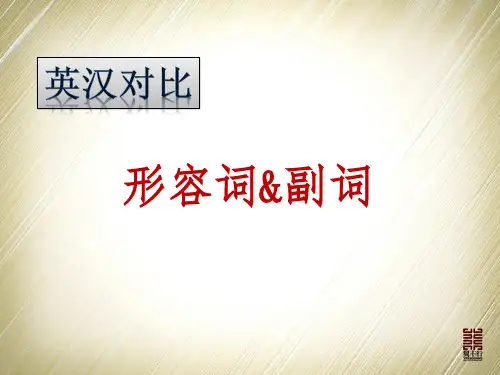
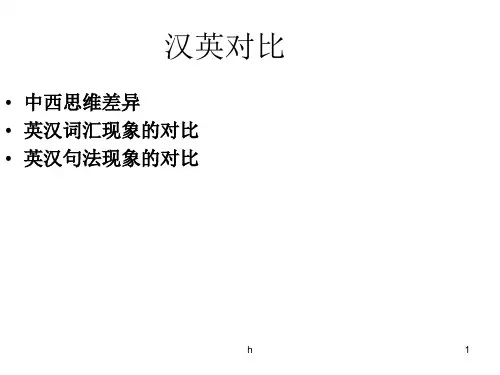
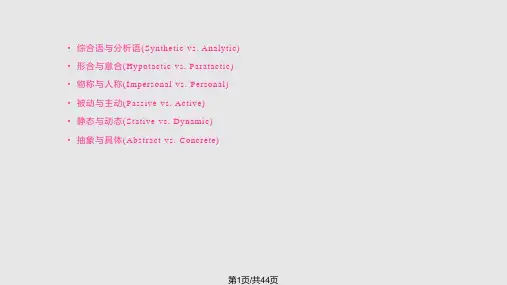
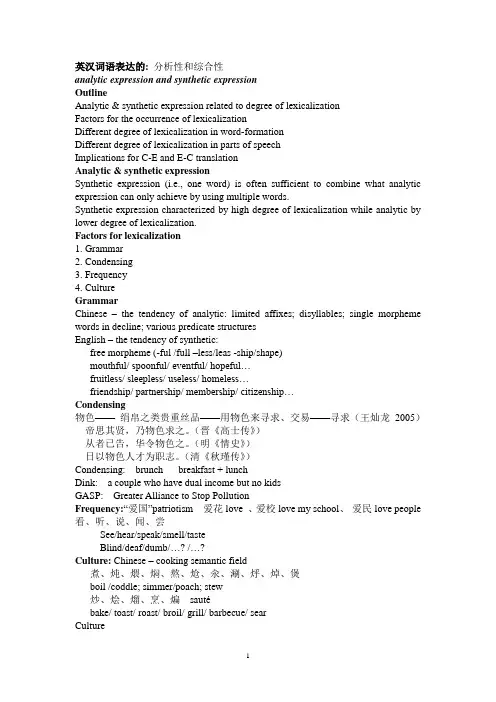
英汉词语表达的: 分析性和综合性analytic expression and synthetic expressionOutlineAnalytic & synthetic expression related to degree of lexicalizationFactors for the occurrence of lexicalizationDifferent degree of lexicalization in word-formationDifferent degree of lexicalization in parts of speechImplications for C-E and E-C translationAnalytic & synthetic expressionSynthetic expression (i.e., one word) is often sufficient to combine what analytic expression can only achieve by using multiple words.Synthetic expression characterized by high degree of lexicalization while analytic by lower degree of lexicalization.Factors for lexicalization1. Grammar2. Condensing3. Frequency4. CultureGrammarChinese –the tendency of analytic: limited affixes; disyllables; single morpheme words in decline; various predicate structuresEnglish – the tendency of synthetic:free morpheme (-ful /full –less/leas -ship/shape)mouthful/ spoonful/ eventful/ hopeful…fruitless/ sleepless/ useless/ homeless…friendshi p/ partnership/ membership/ citizenship…Condensing物色——绢帛之类贵重丝品——用物色来寻求、交易——寻求(王灿龙2005)帝思其贤,乃物色求之。

第六讲英汉语形容词对比
Outline
定义
英汉形容词与句法成分
英汉形容词形态
翻译
定义
形容词(adjective)的概括意义是表示事物特征的词,即形容词可对名词起修饰、描绘的作用。
注意:
形容词是说明名词所表示事物的属性或特征的词;
该词类是一种开放的词类。
英汉形容词与句法成分
宏观上:
英语adj. :主语补语、宾语补语、定语
汉语adj.:主、谓、宾、补、定、状.
功能最为广泛。
具体来说
1.特殊句法成分:
英语形容词可以用作状语,修饰整个句子
Contrary to what I thought, the play was quite successful.
英语中有些形容词只能做表语,而不能做前置定语,特别是以“a”开头的形容词,如asleep, alike, alive,afraid, content, able等。
汉语形容词可以做动词补语,如:洗干净,说明白,长得高,形容词自己也可以带补语,如:好极了,好得很。
2.形态:
①. 形容词标记:英语形态比汉语发达,多数形容词有区别于名词的词形,如beautiful/beauty great/greatness ,但有的形容词词形不变,如square,round,red,white,yellow,green等. 汉语形容词与相对应的名词词形不变,如热情
②.英语: adj. 比较级和最高级加er/ erst,
但多音节词在前加more/less,或most/least,
汉语通过词汇手段(lexical devices)实现
形容词翻译要注意的问题:
汉语叠式形容词一般只能意译。
乱蓬蓬的胡子unkempt/scraggly beard
亮堂堂的brightly lit
绿油油的rich green; glistening green
冷冰冰的icy cold
红彤彤的bright red
或按英语的表达式来译:
老老实实。
勤勤恳恳。
Be honest and industrious
我们应扎扎实实地把这个问题解决好。
We should work in a down-to-earth way and solve this problem.
False friends
A golden age / A gold watch / A gilded age
A wooden face(呆板的脸)/ A wood floor
Her pleasing manner / Her pleased look
下面词组与句子意义也各不相同
He has (a) few friends.
He has only a few relatives. (quite)
Not a few read from habit.(not a few/little=many/much)很多人依习惯来读书。
The man responsible / A responsible man
汉语中的“比”的翻译:
这本书比那本书的风格好。
This book is superior to that one in style.
有色人种绝不比白人差。
Colored people are by no means inferior to white people.
这本小说比较容易读。
This novel is comparatively /relatively easy to read.
英语形容词
1. 用作定语(attributive)
The sky was a garden of golden flowers, heavy with colors.
2. 做表语(predicative)
The food tastes delicious.
3. 用作补语(complement)
They came to the worksite, happy and gay.
We must always keep our rooms clean and tidy.
4. 用作状语(adverbial)
Contrary to what I thought, the play was quite successful.
5.英语中有些形容词只能做表语,而不能做前置定语,特别是以“a”开头的形容词,如asleep, alike, alive,afraid, content, able等。
6、英语形态比汉语发达,多数形容词有区别于名词的词形,如beautiful/beauty great/greatness difficult/difficulty science/scientific poem/poetic language/linguistic等,但有的形容词词形不变,如square,round,red,white,yellow,green等
7.英语有的形容词有特殊的比较级和最高级形式,如good,bad,但多音节形容词的比较级和最高级在形容词前加more/less,或most/least,这种表达方式类似于汉语,即通过词汇手段(lexical devices)实现。
汉语形容词:
汉语形容词与相对应的名词词形不变,如热情
汉语形容词可以做动词补语,如:洗干净,说明白,长得高,形容词自己也可以带补语,如:好极了,好得很。
概括的讲,英语adj.能充当主语补语、宾语补语、定语。
汉语的形容词能跟主、谓、宾、补、定、状各种句法成分对应,即可以做这其中的各种句法成分,功能最为广泛。
在英语中做状语的一般是副词,但汉语中的形容词,特别是状态形容词即可以修饰名词,也可以修饰动词,如“远远的/地”、“好好的/地”、“慢腾腾的/地”“规规矩矩的/地”等。
词形:英语形容词能受very的修饰,有比较级和最高级。